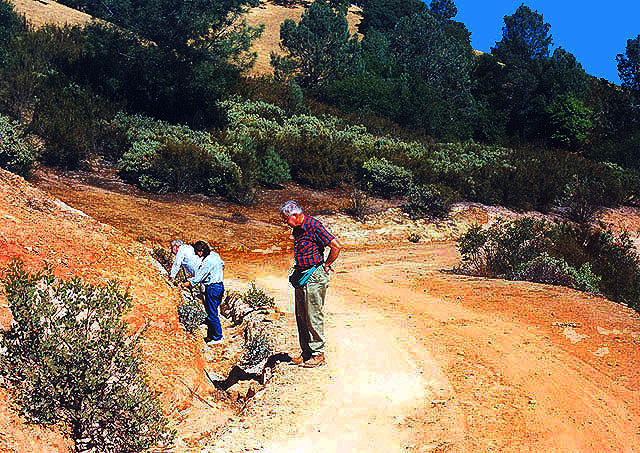
|
This is a view to a very productive fossil leaf locality in the Middle Eocene Ione Formation--a photograph snapped during a field trip to the Ione Basin with my late father (red plaid shirt, an Engineering Geologist) and paleobotanists Dr. Diane Erwin (blue-jeans; Collections Manager of Fossil Plants at the University California Museum Of Paleontology in Berkeley) and Howard Schorn (retired Collections Manager of Fossil Plants at UCMP). I had discovered this site during one of my excursions to the Ione Basin in the mid 1990s. The locality lies very high in the Ione Formation, near the contact with the overlying Lower Miocene Valley Springs Formation, which is marked by the pale-brown, grass-covered slopes at upper right and upper center of the image. It was among the first areas we visited during our field trip to the Ione Basin--Howard and Diane pulled out several quality fossil leaves from this site that day. Vegetation in background includes, primarily, manzanita (pale-greenish brush), maul oak and Digger Pine. Image snapped on October 19, 1999. In late 1998 I had donated to the University California Museum Of Paleontology in Berkeley my extensive collections of fossil plants from the Middle Eocene Ione Formation, Ione Basin, Amador County, California--an entire U-Haul van full of boxes stuffed with plants, not only from the Ione Formation, but also from many other Tertiary Period plant localities in California, Nevada and Idaho. I could well be mistaken, but I do believe that these were the very first fossil plants ever to be housed in a museum from the Ione Basin. Included with the paleobotany collections were several pages of detailed locality data; during my occasional excursions to the fossil fields, I had used a Magellan GPS instrument to record the precise position of all of my fossil plant localities I came across in the Ione Basin. Of course, not every fossil site in the Ione Basin produced beaucoup plants of extraordinary preservation. Some sites yielded only a tantalizing paucity of Eocene plants--just enough paleobotany to whet the proverbial paleontology appetite; perhaps with more extensive excavations such ostensibly unproductive places could be transformed into major producers of paleobotanical specimens. The mysteries were many, indeed. In the fall of 1999, I received an email from paleobotanist Howard Schorn (retired Collections Manager Of Fossil Plants at the University California Museum Of Paleontology in Berkeley). He and Dr. Diane Erwin (the present Collections Manager Of Fossil Plants at UCMP) wanted to visit the Ione Basin paleobotany fossil bonanza to field check, observe first-hand, some of the fossil plant sites I had discovered. This was terrific news, indeed! After we had arranged a date to meet--on a Saturday, October 19, 1999, I got down to business. I needed to contact several of the local landowners in the area, to request permission to enter their properties with Mr. Schorn and Dr. Erwin. After a series of pleasant conversations on the phone, plus a few carefully crafted letters to the property holders, each of the land owners graciously allowed access for the day. And so, the hunt was on... Please note: All fossil localities in the Ione Formation of Amador County, California, presently occur on private property; explicit permission from the land owners must be secured before collecting fossils there. |